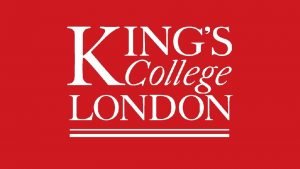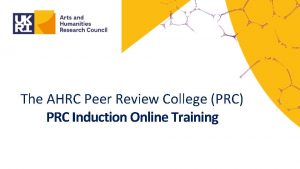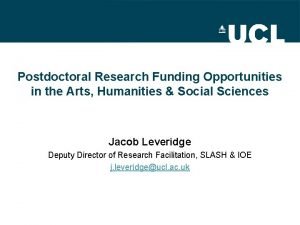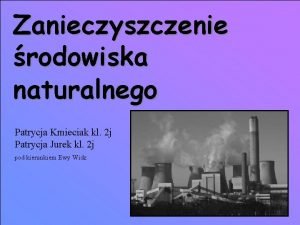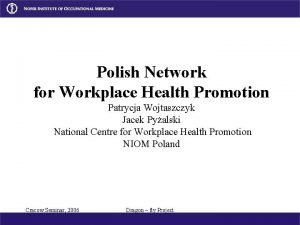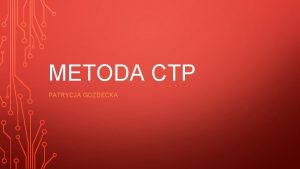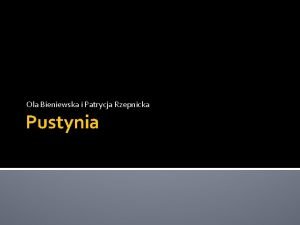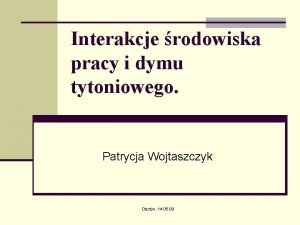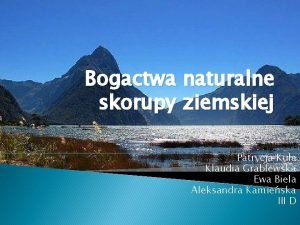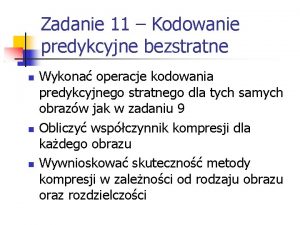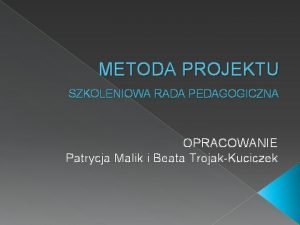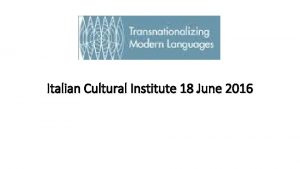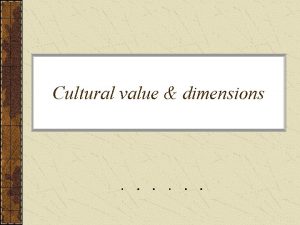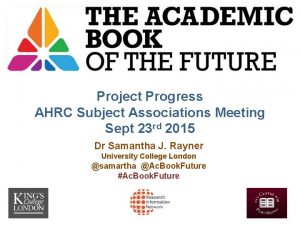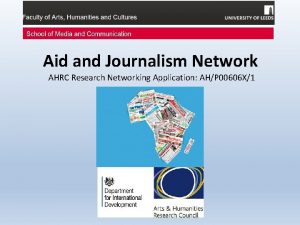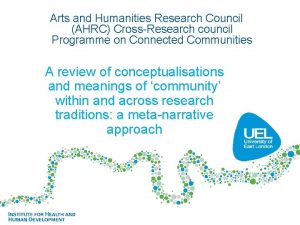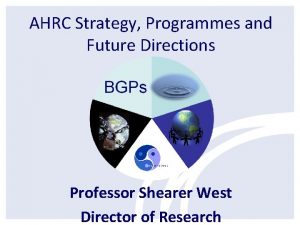Dr Patrycja Kaszynska AHRC Cultural Value Project and











- Slides: 11


Dr Patrycja Kaszynska AHRC Cultural Value Project and the Cultural Value Scoping Project The Relevant Museum – Between Core Values and Hard Cash 1 November 2016

‘But is it realistic to measure these “soft values”, and if so, how it can be done? ’ My talk can be summarised in terms of a dual shift: from ‘soft’ to fundamental from measurement to evaluation

What was the AHRC Cultural Value Project? • A research initiative set up by the Arts and Humanities Research Council in the autumn of 2012; the final report launched in April 2016 • Funded nearly 70 academically-led, separate projects. Mostly original research but also critical reviews of literature in key areas and workshops, conferences and symposia • Dual objective: a) to advance our understanding of cultural value and b) to refine the methods we use to capture or evaluate this value http: //www. ahrc. ac. uk/documents/publications/cultural-value-project-final-report/

Why was the AHRC Cultural Value Project? Dissatisfaction with the way we talk about the importance of art and culture in the context directly shaped by making case for public funding • It did not always produce credible answers • It is in some ways self-defeating I don’t know anyone in the arts who does it directly to have an economic impact. In the same way, governments don’t fund culture to stimulate national economies. As Robert Peston, a British economist said, ‘If we could prove conclusively that the economic impact of the arts was zero, would we therefore prevent children from learning to draw? ’ No, we should not give up on economy, but this is not where we start

Breaking away from the NPM framework • New Labour and the New Public Management framework Increase in spending on the arts and culture but also ‘defensive instrumentalism’ • Criticism of the NPM but actions still embedded in the culture of data-collecting and impact demonstration Something with which the cultural sector complied by generating data and evaluation reports and frameworks (for museums specifically, Generic Learning Outcomes, Generic Social Outcomes and Generic Wellbeing Outcomes).

Reconfiguration of benefits; repositioning of first-hand experience At the heart of the CVP Report was repositioning of first-hand experience – making the individual engagement with culture the starting point Not to restore the outdated arguments about the intrinsic value but because we have to recognise that the secondary, instrumental benefits flow from what happens in the very experience of cultural engagement This is reflected in the framework approach we established • We looked at a range of traditional areas: Community, Regenerations and Space; Economy: impact, innovation and ecology; Health, ageing and wellbeing; Arts in education. • The central two components of cultural value – and the start of our analysis - were ‘Reflective Individual’ and ‘Engaged Citizen’

A better balance between words and numbers • There’s nothing wrong with numbers in some contexts - Hasan Bakhshi and Daniel Fujiwara ‘Measuring economic value in cultural institutions’ • It is important to recognise the limits of quantitative approaches and what quantification presupposes – the ‘problem’ with applying measurement to questions for which it is not suited • Methods have to be appropriate as well as rigorous - embrace a range of methods and accept that rigorous qualitative evidence is not less valid that quantitative evidence. ‘qualitative methods of data gathering including observations, interviews and focus group discussions, together with analytical techniques such as narrative, thematic and content analysis, are important tools for a deeper analysis of arts-based interventions. ’ (Clift, 2012, p. 123). ‘mixed methods can offer the dual benefits of scientific rigour backed up by statistical power afforded from quantitative methods, coupled with the richness and deeper, more contextualised understanding afforded by qualitative approaches. ’ (Chatterjee & Noble, 2013, p. 105).

What does it mean in practical terms for the museum sector? • The Horniman Museum’s exhibitions - Revisiting Romania: Portraits from London (2014 -15) and Revisiting Romania: Dress and Identity (2014 -15) • National Museums Liverpool - House of Memories • 9 museums coordinated by the Research Centre for Museums and Galleries, University of Leicester - Disability Representation in Museums and Galleries

Concluding thoughts: Asking questions differently and asking different questions Although it might not be realistic to measure the so called ‘soft outcomes’, it is possible and necessary to evaluate those more ‘difficult’ - fundamental - manifestations of cultural value Courage is needed short term but the long-term vision will pay off Once we understand the difference arts & culture makes…advocacy will be easier (but it isn’t initially about that)

Cultural Value Scoping Project An initiative supported by Arts & Humanities Research Council, Paul Hamlyn Foundation and King’s College London, in partnership with Arts Council England Please get in touch: patrycja. kaszynska@kcl. ac. uk
